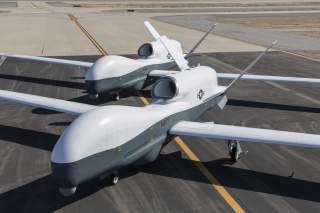Why Iran's Destruction of an American Drone Matters
A real problem.
Northrop built four BAMS-D drones starting in 2008. The Navy has stationed two of them in the United Arab Emirates for operational use as it prepares to deploy the full MQ-4C naval version of the Global Hawk starting in late 2019.
The shoot-down of a U.S. Navy surveillance drone on June 20, 2019 underscores a weakness in the Pentagon’s surveillance forces.
Aside from a few classified vehicles, the U.S. military largely relies on slow, non-stealthy manned and unmanned aircraft for intelligence, surveillance and reconnaissance. Those ISR systems are vulnerable to the latest Iranian, Chinese and Russian air defenses.
The Iranian Revolutionary Guard Corps claimed it shot down a “U.S.-made Global Hawk surveillance drone” flying in Iranian air space near the Strait of Hormuz.
(This first appeared in June 2019.)
U.S. Central Command clarified that the drone was a Navy Broad Area Maritime Surveillance Demonstrator, a prototype naval variant of the 737-size Global Hawk. BAMS-D carries cameras and a radar and is designed to swoop between high and low altitudes, alternately scanning wide areas for ships then individually identifying them.
Northrop built four BAMS-D drones starting in 2008. The Navy has stationed two of them in the United Arab Emirates for operational use as it prepares to deploy the full MQ-4C naval version of the Global Hawk starting in late 2019.
While it can fly as high as 65,000 feet, beyond the reach of many air-defense systems, the BAMS-D is subsonic and lacks stealth features, making it vulnerable to the most powerful surface-to-air missiles. Iranian forces claimed they used a version of the Buk M1 road-mobile SAM to shoot down the BAMS-D. The IRGC also possesses Russian-made S-300 air-defense systems.
U.S. Air Force U-2 manned spy planes, RC-135 manned electronic-intelligence aircraft, E-3 manned radar planes and RQ-4 and MQ-9 drones as well as Navy MQ-4s and P-8 patrol planes—hundreds of aircraft, in total—all are what the military calls “non-penetrating,” meaning they are vulnerable to high-end air defenses.
The only penetrating ISR vehicles in U.S. service that we know of are a small number of subsonic RQ-170 and RQ-180 stealth drones. The last manned penetrating ISR platform, the Mach-three SR-71, retired from Air Force service in the late 1990s.
The Air Force for one knows it has a problem. In late 2018 the flying branch published a new ISR strategy that called for more survivable vehicles.
“We need to balance our ISR portfolio to meet the challenges of a highly contested environment,” stated Lt. Gen. Dash Jamieson, the Air Force’s deputy chief of staff for ISR. “The future will consist of a multi-domain, multi-intelligence, government/commercial-partnered collaborative sensing grid. It will be resilient, persistent and penetrating to support a range of options across the spectrum of conflict.”
Concerns over survivability compelled the Air Force in mid-2018 to cancel a $7-billion effort to replace the service’s aging E-8 ground-surveillance planes with a newer manned aircraft. Instead of buying another big, slow, non-stealthy aircraft, the Air Force doubled down on the Advanced Battlefield Management System, which could install ground-surveillance capability in a wide array of expendable drones and supersonic stealth fighters.
In early 2019 the Center for Strategic and Budgetary Assessments, a Washington, D.C. think tank, proposed that the Air Force cut the number of surveillance squadrons from 40 to 33 and replace many old, non-stealthy ISR aircraft with 120 new penetrating ISR planes, presumably drones.
Not coincidentally, Lockheed Martin for years has been developing a new Mach-six penetrating spy drone it calls the SR-72, a reference to the long-retired SR-71. Lockheed has said little about the SR-72 since announcing the development effort back in 2013.
A Lockheed executive in 2018 hinted that a flyable SR-72 might already exist. Jack O'Banion, a Lockheed vice president, “made mysterious comments about the ultra-secret project at the American Institute of Aeronautics and Astronautics' annual SciTech Forum,” Business Insider reported.
According to Bloomberg, O'Banion said that new design tools and more powerful computers had brought about a "digital transformation." "Without [that] digital transformation, the aircraft you see there could not have been made," O’Banion said while displaying a slide including an artist’s impression of the SR-72.
David Axe serves as Defense Editor of the National Interest. He is the author of the graphic novels War Fix, War Is Boring and Machete Squad.
Image: Wikimedia

